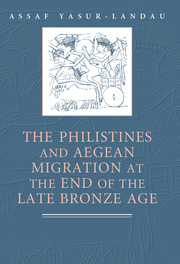Book contents
- Frontmatter
- Contents
- Acknowledgments
- INTRODUCTION
- 1 THE ARCHAEOLOGICAL IDENTIFICATION OF MIGRATION AND OTHER RANGES OF INTERREGIONAL INTERACTIONS
- 2 SETTING THE SCENE: THE MYCENAEAN PALATIAL CULTURE AND THE OUTSIDE WORLD
- 3 THE TWELFTH-CENTURY-BCE AEGEAN: POLITICAL AND SOCIAL BACKGROUND
- 4 PRECONDITIONS FOR MIGRATION
- 5 ALONG THE ROUTES
- 6 STRICTLY BUSINESS? THE SOUTHERN LEVANT AND THE AEGEAN IN THE THIRTEENTH TO THE EARLY TWELFTH CENTURY BCE
- 7 THE MATERIAL CULTURE CHANGE IN TWELFTH-CENTURY PHILISTIA
- 8 THE PHILISTINE SOCIETY AND THE SETTLEMENT PROCESS
- 9 A SHORT HISTORY OF THE AEGEAN IMMIGRATION TO THE LEVANT
- Bibliography
- Index
6 - STRICTLY BUSINESS? THE SOUTHERN LEVANT AND THE AEGEAN IN THE THIRTEENTH TO THE EARLY TWELFTH CENTURY BCE
Published online by Cambridge University Press: 04 August 2010
- Frontmatter
- Contents
- Acknowledgments
- INTRODUCTION
- 1 THE ARCHAEOLOGICAL IDENTIFICATION OF MIGRATION AND OTHER RANGES OF INTERREGIONAL INTERACTIONS
- 2 SETTING THE SCENE: THE MYCENAEAN PALATIAL CULTURE AND THE OUTSIDE WORLD
- 3 THE TWELFTH-CENTURY-BCE AEGEAN: POLITICAL AND SOCIAL BACKGROUND
- 4 PRECONDITIONS FOR MIGRATION
- 5 ALONG THE ROUTES
- 6 STRICTLY BUSINESS? THE SOUTHERN LEVANT AND THE AEGEAN IN THE THIRTEENTH TO THE EARLY TWELFTH CENTURY BCE
- 7 THE MATERIAL CULTURE CHANGE IN TWELFTH-CENTURY PHILISTIA
- 8 THE PHILISTINE SOCIETY AND THE SETTLEMENT PROCESS
- 9 A SHORT HISTORY OF THE AEGEAN IMMIGRATION TO THE LEVANT
- Bibliography
- Index
Summary
The situation along the land and sea routes to the southern Levant in the transition between the thirteenth and twelfth centuries showed a clear shift in the interaction patterns with the Aegean world. This chapter, by analyzing the interaction with the Aegean in this time, sets the background for the study of interactions in the southern Levant during a period of transition. First, as it was argued by Sherratt (1998) and Bauer (1998) that commercial contact in the thirteenth and twelfth centuries had inaugurated processes of elite emulation and adoption of Aegean-style wine drinking customs in the twelfth century, it will be examined whether trade interactions with the Aegean in the thirteenth century, mainly the consumption of imported Mycenaean pottery, caused a lasting change in local behavioral patterns that manifested in the twelfth century. Second, the presence of mercenaries and merchants – if that can be archaeologically established – may indicate a channel through which information about the Levant as a possible migration destination trickled into the Aegean. If such presence persisted into the twelfth century, it could have assisted potential migrants during the time of settlement.
MYCENAEAN IMPORTS TO THE SOUTHERN LEVANT
TRADE AND CONSUMPTION OF MYCENAEAN IMPORTED POTTERY
Imported Mycenaean pottery appears in the vast majority of the Late Bronze Age sites of Canaan, mainly those in the coastal plain and in the valleys (Killebrew 1998b: 160). Mycenaean pottery appears both in settlement levels and as offerings in tombs.
- Type
- Chapter
- Information
- Publisher: Cambridge University PressPrint publication year: 2010



